Waste canvas cross stitch is a unique and versatile technique that combines the art of cross-stitch with the flexibility to embellish a wide range of fabrics and surfaces.
This innovative method utilizes a grid-like, water-soluble canvas that acts as a temporary guide for intricate cross-stitch patterns.
It enables craft enthusiasts to apply their needlework skills to materials not conventionally suited for embroidery, such as clothing, accessories, home decor, and more.
Once the stitching is complete, the waste canvas is gently dissolved or removed, leaving behind a meticulously detailed cross-stitched design.
This craft offers a creative avenue for personalization, decoration, and the transformation of everyday items into one-of-a-kind, handcrafted pieces of art.
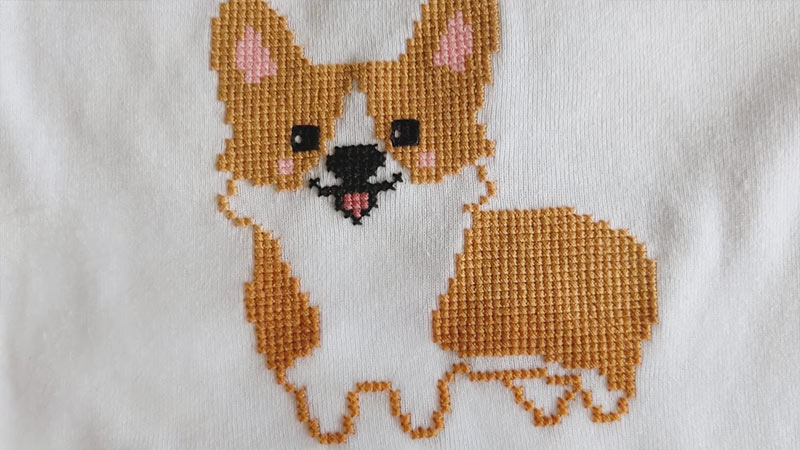
What Is Waste Canvas Cross Stitch? -Definition & How Does it Work
Waste canvas cross stitch is a crafting technique that combines traditional cross-stitch with the convenience of working on fabric that can later be easily removed.
It’s a method that allows cross-stitch enthusiasts to apply their intricate designs to various types of fabrics or materials that are not inherently suitable for cross-stitching, such as clothing, tote bags, or home decor items.
The term “waste canvas” refers to a grid-like, open-weave fabric that is used as a temporary guide for stitching cross-stitch patterns on other materials.
This canvas is often made from a soluble or disintegrating material, which can be removed after the cross-stitching is completed, leaving only the stitched design on the target fabric.
Waste canvas allows for precision and control, ensuring that the cross-stitch design is accurately reproduced on the chosen material.
Here’s how waste canvas cross stitch typically works:
Choosing the Design
Begin by selecting the cross-stitch pattern or design that you want to transfer onto your target fabric. You can choose from a wide variety of patterns or create your own.
Selecting the Target Fabric
Waste canvas cross stitch can be applied to a range of fabrics or materials, including clothing, pillowcases, tote bags, and more.
Ensure that the fabric is stable and can accommodate the cross-stitch design without stretching or distorting.
Preparing the Waste Canvas
Cut a piece of waste canvas to the desired size, making sure it’s large enough to accommodate the entire design.
The waste canvas is then basted or pinned onto the target fabric. It acts as a guide for your cross-stitching.
Cross-Stitching
Cross-stitch the design onto the waste canvas, following the grid lines of the canvas. Use embroidery floss or thread to complete the stitches. The waste canvas helps maintain even spacing and precise placement of stitches.
Removing the Waste Canvas
Once the cross-stitching is complete, you need to remove the waste canvas. This is typically done by moistening the canvas, either with water or by dabbing it with a damp cloth.
The waste canvas dissolves or disintegrates, leaving only the stitched design behind on the target fabric.
Finishing Touches
After removing the waste canvas, you may need to do some finishing work, like securing loose threads, ironing, or framing the cross-stitched design, depending on your project’s requirements.
What Is Waste Canvas Cross Stitch Used For?
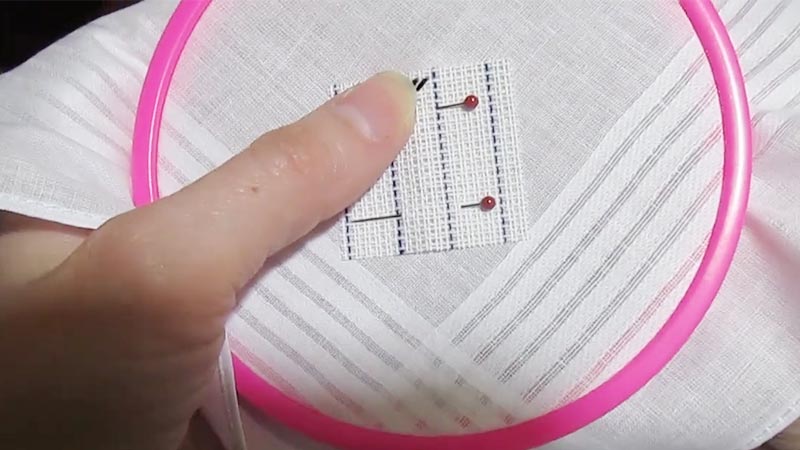
Waste canvas cross stitch is a versatile technique that can be used for a variety of creative and decorative purposes.
Its primary advantage is the ability to apply cross-stitch designs to materials that are not traditionally suitable for embroidery.
Here are the common uses for waste canvas cross stitch:
Clothing Embellishment
Waste canvas cross stitch allows you to personalize clothing items such as T-shirts, jeans, jackets, and even hats with intricate cross-stitch patterns. This is an excellent way to create one-of-a-kind, custom apparel that showcases your unique style.
Home Decor
Cross-stitch can add a charming and handmade touch to your home decor. You can use waste canvas to cross-stitch designs on items like throw pillows, tablecloths, curtains, and even lampshades. These decorative elements can enhance the overall aesthetic of your living space.
Accessories
Waste canvas cross stitch can be applied to accessories like handbags, tote bags, scarves, and hats. It’s a wonderful way to transform plain accessories into fashion statements that reflect your personality and creativity.
Gifts
Handcrafted items make thoughtful and personalized gifts. You can use waste canvas cross stitch to create unique gifts for your friends and family.
Cross-stitched designs on items like handkerchiefs, towels, or baby blankets can be treasured keepsakes.
Holiday Decorations
Celebrate holidays and special occasions with cross-stitched decorations. Waste canvas cross stitch can be used to create ornaments, stockings, and other festive items that you can display during the holiday season.
Baby Nursery Decor
Cross-stitched designs on baby blankets, crib sheets, and wall art can add a touch of charm to a nursery. They make for excellent gifts for expecting parents or to decorate your own child’s space.
Personalized Monograms
Waste canvas is ideal for creating personalized monograms or initials on various fabric items. Monogrammed linens, towels, and even clothing items are a classic and elegant way to add a personal touch to your surroundings.
Mending and Repair
In some cases, waste canvas cross stitch can also be used to mend or repair fabric items with decorative stitching. It can cover up stains or tears in a creative and aesthetically pleasing manner.
Educational and Creative Projects
Waste canvas crossstitch is a great educational tool for teaching kids the art of cross stitch. It can also be used in school projects or DIY crafting workshops to introduce individuals to the world of embroidery.
Customized Logos and Branding
Businesses and organizations can use waste canvas cross stitch to create custom logos and branding on uniforms, promotional items, and merchandise, adding a personal and unique touch to their products.
Types of Waste Canvas Stitch Patterns
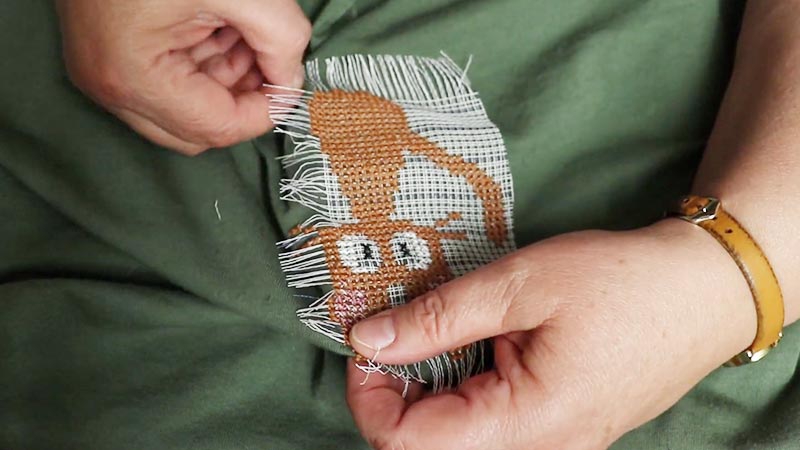
Waste canvas cross-stitch patterns come in various designs and styles, just like traditional cross-stitch patterns. The choice of pattern depends on your preferences and the project you have in mind.
Here are some common types of waste canvas cross-stitch patterns:
Traditional Cross Stitch Patterns
These include classic designs such as flowers, animals, geometric shapes, and simple motifs. They are often used for general decoration and personalization on various items.
Alphabet and Monogram Patterns
Alphabet patterns allow you to create customized text or monograms. They are popular for adding initials, names, or messages to clothing, accessories, and home decor.
Seasonal and Holiday Patterns
These patterns feature images and motifs associated with specific holidays and seasons, such as Christmas trees, Easter eggs, Halloween pumpkins, and Thanksgiving turkeys. They are ideal for creating festive decorations.
Nature and Landscape Patterns
Patterns depicting landscapes, seascapes, and nature scenes like forests, mountains, and ocean views can add a touch of the outdoors to your home decor or accessories.
Floral and Botanical Patterns
Flower and plant-themed patterns are popular for adding a touch of natural beauty to your projects. You can find patterns featuring a single flower or a bouquet of blooms.
Geometric and Abstract Patterns
Geometric shapes, abstract designs, and modern art-inspired patterns offer a contemporary and artistic flair to your cross-stitch projects. They are perfect for fashion-forward and avant-garde designs.
Character and Cartoon Patterns
These patterns feature beloved cartoon characters, superheroes, or other pop culture figures. They are great for children’s clothing and accessories.
Vintage and Retro Patterns
Vintage and retro patterns evoke a sense of nostalgia and are perfect for creating a vintage look on clothing and home decor items.
Sampler Patterns
Samplers are collections of different stitches, motifs, and borders in a single design. They’re often used to practice or showcase a variety of stitching techniques in one piece.
Quirky and Whimsical Patterns
These patterns feature fun and whimsical motifs, such as quirky animals, humorous sayings, or unexpected combinations. They add a playful and light-hearted touch to your projects.
Tribal and Ethnic Patterns
Inspired by traditional tribal and ethnic art, these patterns incorporate motifs and designs from various cultures, adding a unique and cultural flair to your work.
Religious and Spiritual Patterns
Patterns featuring religious symbols, such as crosses, mandalas, or religious figures, can be used for creating spiritual or inspirational items.
Food and Drink Patterns
If you’re a foodie, you can find patterns of your favorite dishes, fruits, and beverages to stitch onto kitchen towels, aprons, or even clothing.
Sports and Hobbies Patterns
Patterns related to sports, hobbies, or interests, such as soccer balls, musical instruments, or travel-themed motifs, can be used to express your passions.
Abstract and Contemporary Art Patterns
For a more avant-garde approach, abstract and contemporary art-inspired patterns offer a unique way to showcase artistic creativity.
How to Remove Waste Canvas Cross Stitch?
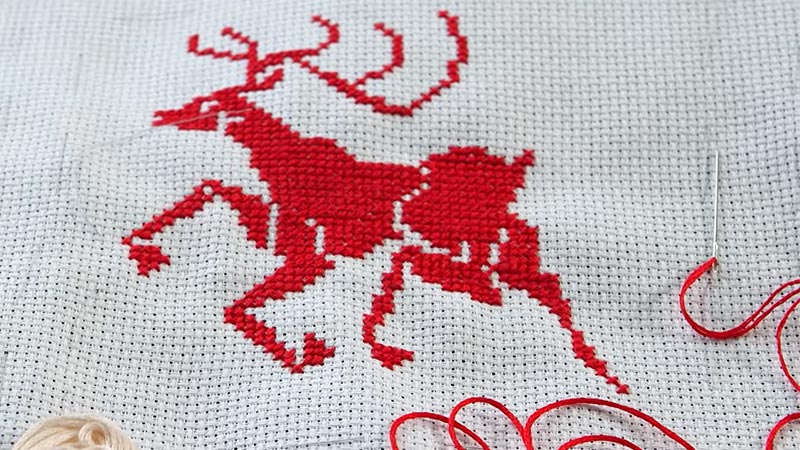
Removing waste canvas after completing your cross-stitch project is a crucial step in the process. The goal is to leave behind the stitched design on the target fabric while removing the waste canvas. Here are the steps to remove the waste canvas from a cross-stitch project:
Gather Your Supplies
- Completed cross-stitch project with the waste canvas attached.
- A bowl or basin of lukewarm water.
- Tweezers or a small pair of embroidery scissors.
- A clean, soft cloth or paper towel.
- A flat, clean surface to work on.
Dampen the Waste Canvas
Submerge the stitched project, including the waste canvas, in the lukewarm water. Allow it to soak for a few minutes. This step will soften the waste canvas fibers and make them easier to remove.
Begin Dissolving the Waste Canvas
Carefully check the waste canvas to see if it’s starting to dissolve or weaken. Gently rub a small section of the waste canvas with your fingers.
You’ll notice that the fibers will start to break down, and you can begin to lift them away from the project.
Remove the Waste Canvas Threads
Using tweezers or embroidery scissors, start to lift and pull away the dissolved threads of the waste canvas. Be extremely gentle to avoid damaging the stitched design or the target fabric. Pull the threads one by one or in small sections.
Continue Removing Threads
Continue to dampen and remove the waste canvas threads in small sections. Take your time and be patient, especially if you have a complex or detailed design.
Inspect and Adjust as Needed
Periodically check the back of the project to ensure all waste canvas threads have been removed. If any tiny fragments of waste canvas remain, carefully lift them away.
Dry the Project
Once all the waste canvas has been removed, gently blot any excess water from the project using a clean, soft cloth or paper towel. Lay the project flat on a clean, dry surface to air dry completely.
Finishing Touches
After the project has dried, you may need to iron it to remove any wrinkles or distortions. Be sure to place a clean cloth or paper towel over the front of the cross-stitch to protect the stitches while ironing. Iron on a low heat setting, if necessary.
How to Work With Waste Canvas Cross Stitch?
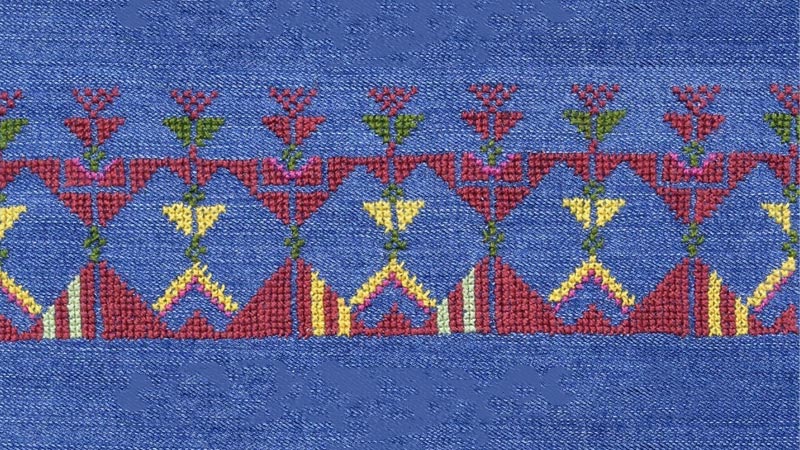
Working with waste canvas in cross stitch allows you to stitch your design onto a fabric that you couldn’t otherwise embroider on directly.
Waste canvas is a gridded fabric that you temporarily attach to your target fabric, stitch your design, and then remove the waste canvas, leaving your design behind. Here’s a step-by-step guide on how to work with waste canvas in cross stitch:
Prepare Your Cross-Stitch Pattern
Start by selecting a cross-stitch pattern that suits your project. Consider the size of the design and ensure it fits well within the area of your fabric or item. Make any necessary adjustments to the pattern, such as resizing or centering it to your liking.
Cut the Waste Canva
Cut a piece of waste canvas slightly larger than your design to ensure full coverage. It should extend beyond the edges of your design to make it easier to secure in place. Trim any excess canvas that may hinder your stitching or alignment.
Prepare the Target Fabric
Before attaching the waste canvas, ensure that your target fabric or item is clean and free of any wrinkles or creases.
Iron it if necessary to create a smooth, even surface for stitching. For fabrics that tend to stretch, like knits, consider using an embroidery hoop to keep the fabric taut.
Position the Waste Canvas
Center the waste canvas on your fabric or item, making sure it’s precisely where you want your cross-stitch design to appear.
You can use pins or basting stitches to secure it in place and prevent any shifting during the stitching process.
Transfer the Design
Using the selected cross-stitch pattern as a guide, begin stitching your design onto the waste canvas. Pay close attention to the grid lines of the canvas to ensure that your stitches align accurately. Use the appropriate embroidery floss or thread for your chosen design.
Complete the Cross-Stitching
Continue stitching until you’ve covered the entire pattern on the waste canvas. Take your time and maintain even tension in your stitches to achieve a polished and professional look.
Remove the Water-Soluble Waste Canvas (for water-soluble only)
Once your stitching is complete, it’s time to remove the waste canvas. To do this, gently dampen the waste canvas with water, ensuring it’s adequately moistened but not oversaturated, which could potentially damage your stitching.
Allow the water to penetrate and dissolve the waste canvas. You may gently rub the canvas with your fingers to expedite the process.
Using tweezers, carefully start pulling away the dissolved threads of the waste canvas. Begin at one corner and proceed systematically across the design, ensuring you don’t damage your meticulously crafted stitches or the underlying fabric.
Finishing and Framing
With the waste canvas removed, your cross-stitched design remains on the target fabric or item. Inspect the project for any loose ends or imperfections, and secure them with additional stitching or knots.
To eliminate any wrinkles or creases, use a low heat setting on your iron and place a clean cloth or paper towel over the front of the cross-stitch to protect the stitches. Iron the fabric gently to achieve a smooth finish.
Your finished cross-stitch project is now ready for framing, sewing into a garment, or any other intended use. These steps ensure a meticulous and professional outcome for your waste canvas cross stitch.
Frequently Asked Questions
Is waste canvas cross stitch suitable for beginners?
Waste canvas cross-stitch can be a bit more challenging than regular cross-stitch due to the additional step of removing the waste canvas.
Can I reuse waste canvas for multiple projects?
Waste canvas is typically intended for one-time use. Once it dissolves or disintegrates, it’s no longer suitable for stitching. It’s best to cut a piece of waste canvas that fits your specific project and discard it after use.
What’s the difference between water-soluble and disintegrating waste canvas?
Water-soluble waste canvas dissolves when exposed to water, making it suitable for removal from your project.
Disintegrating waste canvas tends to break apart into small pieces but doesn’t dissolve. The choice between the two depends on your preference and the ease of removal.
Can waste canvas be used with all types of fabric?
Waste canvas is versatile and can be used with various fabrics, but some fabrics, like very stretchy knits, may require additional stabilizing techniques to prevent distortion during stitching. It’s important to choose a fabric that complements your project’s intended use.
Do I need to wash my cross-stitch project after removing the waste canvas?
After removing the waste canvas, it’s generally a good idea to wash your cross-stitch project to remove any residual starch or sizing from the canvas.
Wrap Up
Waste canvas cross-stitch is a creative and versatile technique that expands the possibilities of cross-stitching.
It empowers craft enthusiasts to adorn a wide range of fabrics and items with meticulously detailed designs, from clothing and accessories to home decor.
This ingenious method, whether using water-soluble or disintegrating waste canvas, brings a world of personalization and artistic expression to everyday objects.
Through a careful process of stitching, dissolving or removing, and finishing, this craft allows individuals to transform ordinary items into unique, handcrafted works of art.
Waste canvas cross-stitch offers the ideal blend of tradition and innovation, where the classic beauty of cross-stitch meets contemporary creativity.
Leave a Reply